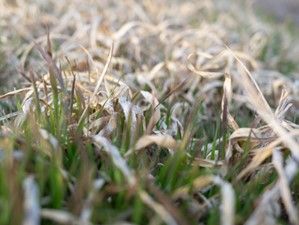As winter winds down here in Cyr Plantation & Caribou, Maine, and the snow melts, we will slowly see our lawns again. Of course, the grass will still be brown and dormant for a while, but that doesn’t mean it can’t give clues about how it fared during the winter. Once people see most of their lawn green up while other areas stay brown, they often chalk those areas up to a loss. Their reasoning is usually, “Oh, it’s just winter kill.”
However, winter kill isn’t a diagnosable condition on its own. Instead, winter kill is a broadly encompassing term that covers several elements directly related to a turfgrass plant’s demise. Most of them are concerned with the physiology of the turfgrass plant itself. To better understand this problem, let’s look at five common causes of winter kill and how to prevent them.
1. CROWN HYDRATION
When looking at the term crown hydration without prior knowledge, one might think that it’s a good thing. With the crown being the central growing point of a turfgrass plant and hydration being essential for said plant, it would sound like a best-case scenario. However, this isn’t the case.
In preparation for the upcoming winter months, turfgrass plants go through a process known as acclimation. Acclimation, also known as dehydration, means water moves out of the plant’s cells through exposure to low but non-freezing temperatures and shorter day lengths gradually. So while the less water inside the plant when below-freezing temperatures are present, the less of a chance for ice crystals to form inside the cells.
In addition to this dehydration, there is an accumulation of carbohydrates and antifreeze proteins within cells. The carbohydrates are responsible for lowering the freezing point of water and serving as reserves to aid in regrowth in the spring. Antifreeze proteins can bind to the surfaces of ice crystals within cells to prevent or slow further crystal growth. All of these factors combined increase the fluidity of the cell membranes, meaning that they have more “give” and are less susceptible to freezing and bursting.
However, as daytime temperatures rise in the spring, turfgrass plants begin to de-acclimate. The problem with this process, especially in Maine, is that once we get a spring thaw, it rarely ever lasts. It is not unusual to have one week in the 50s and then be back to near-freezing and snow the week after.
Unfortunately, plants can’t return to “hardened off” levels once it starts. Instead, the plants will uptake water in response to those warm days. Then, once the temperatures drop back to freezing or below freezing levels, our old friend intracellular freezing comes back into the picture and ruptures plant cells, causing the plant to die.
HOW TO PREVENT CROWN HYDRATION
With all of that in mind, is there anything we can do to avoid this, seeing as we can’t change the physiology of the plant? Well, yes and no. We can’t control the fluctuation of temperatures and other environmental factors, but there are several factors that we can manage to at least influence these physiological processes:
- Keep some height in your lawn before the first frost: While maintaining the proper mowing height is recommended throughout the season, it’s crucial in the late season. Not only does mowing on the higher end of the HOC (height of cut) range promote increased density, but it also aids in the production of carbohydrates (energy), and the longer leaf tissues serve as insulation for the crowns.
- Compaction: Not only does compacted soil decrease the oxygen available to the turfgrass roots, but it also holds more moisture than well-drained soils. Compression, in turn, leads to increased susceptibility to freezing injury.
- Remove thatch buildup: Excessive thatch can tie up valuable nutrients and organic matter. In addition, if the turfgrass crowns are stuck in the thatch layer rather than just above the soil surface where they should be, they are subjected to greater temperature extremes. So be sure to remove thatch every few years to reduce compaction.
- Fertilize your lawn in the fall: As the season winds down, turf no longer grows but remains green for a short time. Green leaf tissue means photosynthesis is still minimally occurring and thus can process specific nitrogen fertilization sources. However, because shoot growth has ceased for the season, the nitrogen bypasses the shoots and goes directly to increasing root mass and carbohydrate reserves in the turfgrass plant.
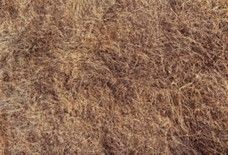
2. DIRECT LOW-TEMPERATURE KILL
Various common turfgrass species are used in home lawns across the country. They are broadly separated into warm and cool-season turfgrasses, with Washington, D.C., being the rough boundary line that splits their native ranges. As you might imagine, the warm-season grasses thrive south of that line, and the cool-season grasses survive in our area. There are varying low-temperature tolerances within that lineup of cool-season species. For example, bluegrasses have been shown to withstand lower temperatures than fescues and ryegrasses.
However, the more influential factors are the levels of solutes within the plant that prevents freezing and, in turn, reduce the capacity to withstand ice formation inside plant tissues. Combine these factors with constantly varying low temperatures and their dynamic interaction, and you have the basics of a direct low-temperature kill.
How To Prevent Direct Low-Temperature Kill
The best way to prevent direct low-temperature kill is to ensure that you have the right grass type for your region. For example, Kentucky bluegrass is recommended to Maine residents because it’s a hardy variety that can withstand freezing temperatures. While it’s a full process, a local lawn care company can help you remove your weak or dead grass and reseed it with a grass type more suitable for winter. This way, your turf has the build to defend itself from freezing temperatures naturally.
3. DESICCATION
Even with the abundance of moisture in our landscapes during the winter in the form of snow, desiccation, the loss of water from a plant beyond which it can’t survive, is something we still need to be concerned about. Turfgrasses can release water into the atmosphere via evapotranspiration, mainly during warmer times during the growing season.
However, this process can still occur during the winter if turf becomes exposed and not covered by snow. This is common in wide-open areas where drifting occurs, leaving large mounds of snow in one area while leaving adjacent areas bare. Then, those open turf areas are subject to the drying effects of harsh winter winds. Once drying out occurs, the plant cannot replenish its reserves via the standard method of liquid water uptake from the soil because the soil is frozen.
How To Prevent Desiccation
The best method to prevent desiccation is to have routine lawn watering year-long. Desiccation results from extreme water loss, so providing your property with plenty of water before the winter season is paramount. A dry fall can increase the likelihood of your turfgrass developing desiccation. If you know that a winter storm is headed your way, deeply water your lawn the week before the freeze. This watering will give your grassroots sufficient water to store and use when the weather warms in the spring.
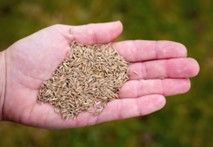
4. ICE ENCASEMENT (ANOXIA)
While snow cover and cold temperatures are common factors during our winter season, we must remember that ice is also part of the picture. Ice wreaks havoc on roadways and power lines, causing vehicle crashes, power outages, and slip-and-fall claims. Ice cover on turf areas can also cause serious problems. The fact that a thick layer of ice is simply resting in its frozen state on your lawn isn’t necessarily a big deal. However, there are two other factors related to it that can cause some issues:
- Toxic gas accumulation: Turfgrass plants utilize oxygen as they respire. Once oxygen reserves are depleted, it creates an oxygen-free environment because the element is not introduced below the ice cover. As a result, a buildup of toxic gasses can cause turfgrass to decompose and die.
- Crown hydration: Our old friend returns and can combine with anoxia to cause turfgrass death. This can occur as the ice melts during warmer temperatures. Then, when things refreeze, death can occur.
How To Prevent Ice Encasement
If icy weather is in the forecast, you can do a couple of things to prevent ice encasement. First, if you already have snow on the ground, leave it on your lawn. While some might think the snow would harm it further, it will prevent the ice from suffocating your grass. Snow is a more porous material than ice and will sit on top of the grass rather than encompass it. As long as the snow isn’t weighty and dense, it is more likely to allow oxygen to flow through the soil and the air.
If you have more susceptible lawn areas, consider investing in a permeable, non-insulating turf cover. This cover can be laid across lawn zones to prevent a thick ice cover and allow your grass to breathe. It can also deter other winter damage, such as desiccation. In addition, by encouraging moisture to stay within the soil, your grass is far more likely to stay hydrated all winter.
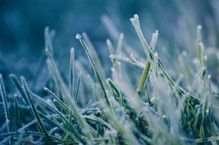
5. SNOW MOLD
Chances are, you’ve seen either one or both of the snow molds that are common as the snow melts away. Gray snow mold, Typhula spp., and pink snow mold, Microdochium nivale, are diseases that require prolonged periods of snow cover to develop. Their symptoms are similar in appearance, displaying themselves as white-crusted areas of grass in which blades are dead, bleached, and matted together. The difference is that pink snow mold creates a pinkish cast around the blighted area.
In contrast, gray snow mold can easily be identified by the presence of hard pinhead-sized fungal bodies called sclerotia, which are light to dark brown and are embedded in the leaves and crowns of the infected grass plants. In many cases, these diseases only reside on dead leaf tissue/thatch left over from the previous season and are usually not a big deal. However, they can also just as easily infect the turfgrass crown, which is a much more extreme issue.
How To Prevent Snow Mold
There are several ways to prevent snow mold in your lawn. First, always ensure that your grass can breathe in the winter. This requires removing fallen leaves and other organic debris in the fall. Plus, continue to mow your lawn until the first frost so long grass doesn’t trap excess moisture. After you remove any excess debris, you can opt for a preventative fungicidal application before the first snowfall. This application will shield your grass from mold trying to penetrate its grass blade tissue.
If your grass has fallen victim to snow molds this winter, healthy turf can heal from snow mold diseases in the spring. This trait makes high-quality lawn care a winner because it keeps your grass hardy and disease-resistant. If your turf becomes a victim of snow mold, it can typically ward off the mold if you resume lawn care and light fertilization as usual in the spring.
HOW TO REPAIR YOUR LAWN FROM WINTER KILL IN THE SPRING
So, after all that information about the different causes of winter kill, there is a little bit more bad news: It’s very challenging to diagnose what exactly caused turf to die over the winter. So, those areas in your lawn that fail to green up come spring must be re-established. However, not all is lost because you’ll start the spring with flourishing young turf!
You have two straightforward choices to re-grow new grass: seed or sod. The decision comes down to budget and the level of maintenance. If you have an early summer wedding planned in your backyard and need a Fenway Park-quality lawn by mid-June, the sod will be your best bet. Sod creates an instant lawn, and with proper watering, fertility, and initial mowing, it will look nearly perfect quickly.
However, seeding may be a more practical option if you’re looking to replace some dead turfgrass along a driveway edge or at the edge of your snowblower path to the fuel pipe. The thing to remember with whichever method you choose is that proper preparation before and sufficient irrigation after will make or break any turfgrass establishment project. Seed or sod, high or low end, the basic principles remain.
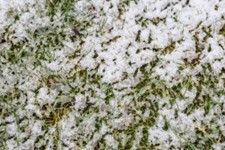
AVOID WINTER KILL WITH HIGH-QUALITY LAWN CARE
Winter kill is no joke. That’s why it’s essential to know how winter kill can creep up on your Maine lawn. Thankfully, there are always preventative measures that you can take to reduce your turf’s risk of damage. Plus, our lawn care specialists are here to identify the damage in your lawn and take action to revive your healthy grass.
We nip winter kill in the bud by providing our customers stellar lawn care. Our Maine lawn care team at Northern Turf Management is here to protect your lawn from winter damage for good. Reach us at (207) 544-9420 to learn more about our winter kill diagnosing and reseeding services.

